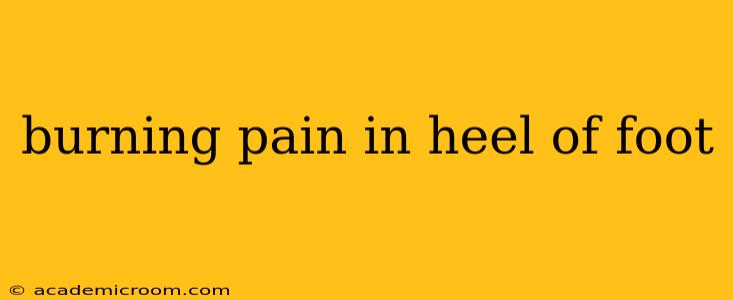Experiencing a burning pain in your heel can be incredibly frustrating and debilitating. This sharp, intense sensation can significantly impact your daily life, making even simple activities like walking challenging. Understanding the potential causes, diagnostic methods, and treatment options is crucial for effective management and relief. This comprehensive guide will explore the various reasons behind heel pain and offer insights into finding the right solution.
What Causes Burning Heel Pain?
Several conditions can contribute to a burning sensation in your heel. The most common culprits include:
-
Plantar Fasciitis: This is arguably the most frequent cause of heel pain. The plantar fascia, a thick band of tissue running along the bottom of your foot, becomes inflamed, causing pain, particularly in the heel. While often described as a sharp pain, burning sensations are also possible, especially with prolonged standing or activity.
-
Heel Spur: A bony growth (spur) on the heel bone can irritate the plantar fascia, leading to pain, often with a burning component. Heel spurs themselves don't always cause pain; it's the associated inflammation that's the problem.
-
Nerve Compression: Conditions like tarsal tunnel syndrome or other nerve entrapments in the foot can result in a burning, tingling, or shooting pain in the heel. This is often accompanied by numbness or weakness.
-
Achilles Tendinitis: While primarily affecting the Achilles tendon, inflammation in this area can sometimes radiate pain into the heel, possibly with a burning quality.
-
Stress Fractures: Repetitive impact or overuse can cause tiny cracks in the heel bone, leading to pain, often described as a deep, burning ache.
-
Bursitis: Inflammation of the bursae (fluid-filled sacs that cushion the heel bone) can cause localized pain, potentially including burning sensations.
-
Other Inflammatory Conditions: Conditions like rheumatoid arthritis or psoriatic arthritis can cause heel pain, including burning, as part of a wider inflammatory process.
What are the symptoms associated with burning heel pain?
The symptoms accompanying burning heel pain can vary depending on the underlying cause, but common indicators include:
- Sharp, stabbing pain: This is often worse in the morning or after periods of rest.
- Burning or tingling sensation: This can feel like a constant or intermittent electrical shock.
- Increased pain with activity: Walking, running, or standing for extended periods can exacerbate the pain.
- Stiffness in the heel: Difficulty flexing the foot.
- Swelling or redness: Inflammation may be apparent around the heel.
- Numbness or tingling: This is more common with nerve-related issues.
How is burning heel pain diagnosed?
A thorough physical examination by a doctor or podiatrist is crucial for diagnosing the cause of your burning heel pain. They will assess your symptoms, medical history, and conduct a physical examination of your foot and ankle. In some cases, imaging tests may be necessary to confirm a diagnosis:
- X-rays: To rule out fractures or heel spurs.
- Ultrasound: To visualize soft tissues and assess for inflammation.
- MRI: To provide detailed images of bones, soft tissues, and nerves.
What are the treatment options for burning heel pain?
Treatment for burning heel pain depends on the underlying cause and severity of the symptoms. Options include:
- Rest and Ice: Resting the foot and applying ice packs can help reduce inflammation and pain.
- Over-the-Counter Pain Relief: Nonsteroidal anti-inflammatory drugs (NSAIDs) like ibuprofen can alleviate pain and inflammation.
- Stretching and Exercises: Specific stretches and exercises can strengthen the plantar fascia and improve flexibility.
- Orthotics: Custom-made or over-the-counter arch supports can help redistribute pressure and alleviate pain.
- Physical Therapy: A physical therapist can provide guidance on exercises, stretches, and other treatments to address the underlying cause of the pain.
- Injections: Corticosteroid injections can help reduce inflammation in cases of plantar fasciitis or bursitis.
- Surgery: Surgery is rarely necessary but may be considered as a last resort for severe cases that haven't responded to other treatments.
How long does burning heel pain last?
The duration of burning heel pain varies depending on the underlying cause and the effectiveness of the treatment. In many cases, plantar fasciitis can resolve within a few months with appropriate treatment. However, some conditions may require longer-term management.
Can burning heel pain be prevented?
While some causes of burning heel pain are unavoidable, several preventative measures can reduce the risk:
- Maintain a healthy weight: Excess weight puts extra stress on your feet and heels.
- Wear supportive footwear: Shoes with good arch support and cushioning can help protect your feet.
- Stretch regularly: Stretching your calf muscles and plantar fascia can help prevent tightness and inflammation.
- Avoid activities that overstress your feet: Gradually increase the intensity and duration of activities to avoid injury.
This information is intended for educational purposes only and should not be considered medical advice. If you are experiencing burning heel pain, consult a healthcare professional for a proper diagnosis and personalized treatment plan. They can assess your specific situation and recommend the best course of action for your individual needs.
